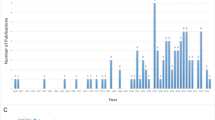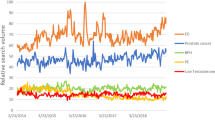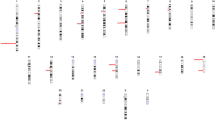Abstract
Male hypogonadism can seriously affect male health and fertility, yet comprehensive bibliometric and visualization analyses of research in this area have been lacking. This study aimed to examine the distribution of literature, identify research hotspots, and discern development trends in male hypogonadism by analyzing 4026 English documents published between 2000 and 2023 using bibliometric and visual analyses. The results indicated a significant increase in publications and citations related to male hypogonadism over the past two decades, with the United States, the University of Florence, Maggi M, and the Journal of Clinical Endocrinology & Metabolism recognized as the most productive and highly cited country, institution, author, and journal, respectively. The article titled “The GPR54 gene as a regulator of puberty” received the highest number of citations. The keywords were categorized into four distinct clusters, including the etiology and pathogenesis of male hypogonadism, symptoms of late-onset hypogonadism, testosterone replacement therapy and its contraindications, the correlation between male hypogonadism and metabolic syndrome (MetS), obesity, and the epidemiology of male hypogonadism. The most frequently co-occurring keywords were “hypogonadism”, “testosterone”, and “men”, while “oxidative stress” was the most prominent burst keyword. The analysis also identified “male infertility” and “oxidative stress” as the primary burst keywords in the last five years, indicating their emerging high-interest topics. Overall, this study provides a comprehensive overview of male hypogonadism research, offering valuable insights for researchers interested in this area, including potential collaborators, current research hotspots, and future research directions.
This is a preview of subscription content, access via your institution
Access options
Subscribe to this journal
Receive 8 print issues and online access
$259.00 per year
only $32.38 per issue
Buy this article
- Purchase on Springer Link
- Instant access to full article PDF
Prices may be subject to local taxes which are calculated during checkout








Similar content being viewed by others
Data availability
The data analyzed in this study can be obtained from the Web of Science database using the search keywords and procedures described in the “Methods” section. The raw search results and bibliometric data are available upon reasonable request to the corresponding author.
References
Bhasin S, Brito JP, Cunningham GR, Hayes FJ, Hodis HN, Matsumoto AM, et al. Testosterone therapy in men with hypogonadism: an endocrine society* clinical practice guideline. J Clin Endocrinol Metab. 2018;103:1715–44.
Yeap BB, Wu FCW. Clinical practice update on testosterone therapy for male hypogonadism: contrasting perspectives to optimize care. Clin Endocrinol. 2019;90:56–65.
Salonia A, Bettocchi C, Boeri L, Capogrosso P, Carvalho J, Cilesiz NC, et al. European Association of Urology guidelines on sexual and reproductive health-2021 update: male sexual dysfunction. Eur Urol. 2021;80:333–57.
Tajar A, Forti G, O’Neill TW, Lee DM, Silman AJ, Finn JD, et al. Characteristics of secondary, primary, and compensated hypogonadism in aging men: evidence from the European Male Ageing Study. J Clin Endocrinol Metab. 2010;95:1810–8.
Corona G, Goulis DG, Huhtaniemi I, Zitzmann M, Toppari J, Forti G, et al. European Academy of Andrology (EAA) guidelines* on investigation, treatment and monitoring of functional hypogonadism in males. Andrology. 2020;8:970–87.
Basaria S. Male hypogonadism. Lancet. 2014;383:1250–63.
Wallin JA. Bibliometric methods: pitfalls and possibilities. Basic Clin Pharm Toxicol. 2005;97:261–75.
van Eck NJ, Waltman L. Software survey: VOSviewer, a computer program for bibliometric mapping. Scientometrics. 2010;84:523–38.
Ellegaard O, Wallin JA. The bibliometric analysis of scholarly production: how great is the impact? Scientometrics. 2015;105:1809–31.
Rondanelli M, Perna S, Peroni G, Guido D. A bibliometric study of scientific literature in scopus on botanicals for treatment of androgenetic alopecia. J Cosmet Dermatol. 2016;15:120–30.
Corona G, Vignozzi L, Sforza A, Mannucci E, Maggi M. Obesity and late-onset hypogonadism. Mol Cell Endocrinol. 2015;418:120–33.
Corona G, Rastrelli G, Monami M, Saad F, Luconi M, Lucchese M, et al. Body weight loss reverts obesity-associated hypogonadotropic hypogonadism: a systematic review and meta-analysis. Eur J Endocrinol. 2013;168:829–43.
Corona G, Rastrelli G, Monami M, Guay A, Buvat J, Sforza A, et al. Hypogonadism as a risk factor for cardiovascular mortality in men: a meta-analytic study. Eur J Endocrinol. 2011;165:687–701.
Chan YM, Broder-Fingert S, Wong KM, Seminara SB. Kisspeptin/Gpr54-independent gonadotrophin-releasing hormone activity in Kiss1 and Gpr54 mutant mice. J Neuroendocrinol. 2009;21:1015–23.
Lapatto R, Pallais JC, Zhang D, Chan Y-M, Mahan A, Cerrato F, et al. Kiss1(-/-) mice exhibit more variable hypogonadism than Gpr54(-/-) mice. Endocrinology. 2007;148:4927–36.
Berthon A, Settas N, Delaney A, Giannakou A, Demidowich A, Faucz FR, et al. Kisspeptin deficiency leads to abnormal adrenal glands and excess steroid hormone secretion. Hum Mol Genet. 2020;29:3443–50.
Seminara SB, Messager S, Chatzidaki EE, Thresher RR, Acierno JS, Shagoury JK, et al. The GPR54 gene as a regulator of puberty. N Engl J Med. 2003;349:1614–U8.
Wu FCW, Tajar A, Beynon JM, Pye SR, Silman AJ, Finn JD, et al. Identification of late-onset hypogonadism in middle-aged and elderly men. N Engl J Med. 2010;363:123–35.
Bhasin S, Cunningham GR, Hayes FJ, Matsumoto AM, Snyder PJ, Swerdloff RS, et al. Testosterone Therapy in Men with Androgen Deficiency Syndromes: An Endocrine Society Clinical Practice Guideline. J Clin Endocrinol Metab. 2010;95:2536–59.
Snyder P. Testosterone treatment of late-onset hypogonadism - benefits and risks. Rev Endocr Metab Disord. 2022;23:1151–7.
Snyder PJ, Bhasin S, Cunningham GR, Matsumoto AM, Stephens-Shields AJ, Cauley JA, et al. Lessons From the Testosterone Trials. Endocr Rev. 2018;39:369–86.
Kondoh N, Kaizuka Y, Nagasawa S, Togo Y, Yamamoto S. Predictive factors for efficacy of testosterone replacement therapy for late-onset hypogonadism in Japanese men: a preliminary report. Asian J Androl. 2023;25:587–90.
Aribarg A, Zhang GY, Cao J, Li GZ, Anderson RA, Swerdloff RS, et al. Contraceptive efficacy of testosterone-induced azoospermia and oligozoospermia in normal men. Fertil Steril. 1996;65:821–9.
Shah R, Patil V, Sarathi V, Lila AR, Zacharin M, Krishnappa B, et al. Prior testosterone replacement therapy may impact spermatogenic response to combined gonadotropin therapy in severe congenital hypogonadotropic hypogonadism. Pituitary. 2021;24:326–33.
Rastrelli G, Filippi S, Sforza A, Maggi M, Corona G. Metabolic Syndrome in Male Hypogonadism. Front Horm Res. 2018;49:131–55.
Garcia-Cruz E, Piqueras M, Huguet J, Perez-Marquez M, Gosalbez D, Peri L, et al. Hypertension, dyslipidemia and overweight are related to lower testosterone levels in a cohort of men undergoing prostate biopsy. Int J Impot Res. 2012;24:110–3.
Dimopoulou C, Goulis DG, Corona G, Maggi M. The complex association between metabolic syndrome and male hypogonadism. Metabolism. 2018;86:61–8.
Taskin HE, Al M. Testosterone Changes in Men With Obesity and Type 2 Diabetes 6 Months After Sleeve Gastrectomy With Transit Bipartition. Surg Laparosc Endosc Percutan Tech. 2022;32:188–96.
Dhindsa S, Ghanim H, Jenkins T, Inge TH, Harmon CM, Ghoshal A, et al. High prevalence of subnormal testosterone in obese adolescent males: reversal with bariatric surgery. Eur J Endocrinol. 2022;186:319–27.
Genchi VA, Rossi E, Lauriola C, D’Oria R, Palma G, Borrelli A, et al. Adipose tissue dysfunction and obesity-related male hypogonadism. Int J Mol Sci. 2022;23:8194.
Finkelstein JS, Lee H, Burnett-Bowie S-AM, Pallais JC, Yu EW, Borges LF, et al. Gonadal steroids and body composition, strength, and sexual function in men. N. Engl J Med. 2013;369:1011–22.
Wake DJ, Strand M, Rask E, Westerbacka J, Livingstone DEW, Soderberg S, et al. Intra-adipose sex steroid metabolism and body fat distribution in idiopathic human obesity. Clin Endocrinol. 2007;66:440–6.
Xu X, Sun M, Ye J, Luo D, Su X, Zheng D, et al. The effect of aromatase on the reproductive function of obese males. Horm Metab Res. 2017;49:572–9.
Wang S-K, Lee M-C, Hung C-L, Chen H-H, Liao C-C, Chiu Y-L. Association between hypertriglyceridemic waist phenotype and hypogonadism in Taiwanese adult men. PLoS ONE. 2022;17:e0265629.
Davidson LM, Millar K, Jones C, Fatum M, Coward K. Deleterious effects of obesity upon the hormonal and molecular mechanisms controlling spermatogenesis and male fertility. Hum Fertil. 2015;18:184–93.
Bellastella G, Menafra D, Puliani G, Colao A, Savastano S, Obesity Programs of nutrition ER. How much does obesity affect the male reproductive function? Int J Obes Suppl. 2019;9:50–64.
Salim S. Oxidative stress and the central nervous system. J Pharm Exp Ther. 2017;360:201–5.
Bisht S, Faiq M, Tolahunase M, Dada R. Oxidative stress and male infertility. Nat Rev Urol. 2017;14:470–85.
Leisegang K, Roychoudhury S, Slama P, Finelli R. The mechanisms and management of age-related oxidative stress in male hypogonadism associated with non-communicable chronic disease. Antioxidants. 2021;10:1834.
Haymana C, Aydogdu A, Soykut B, Erdem O, Ibrahimov T, Dinc M, et al. Oxidative stress status in congenital hypogonadism: an appraisal. Toxicol Mech Methods. 2017;27:451–7.
Unluhizarci K, Sik SK, Keti DB, Kose K, Hacioglu A, Karaca Z. Treatment of male hypogonadism partially reverses oxidative stress in patients with hypogonadism. Endocr J. 2020;67:935–40.
Mancini A, Leone E, Festa R, Grande G, Silvestrini A, De Marinis L, et al. Effects of testosterone on antioxidant systems in male secondary hypogonadism. J Androl. 2008;29:622–9.
Acknowledgements
This study was supported by the National Natural Science Foundation of China (Award Number: 82274325, Recipient: Xujun Yu) and Special Project of Sichuan Provincial Administration of Traditional Chinese Medicine for Scientific Research of Traditional Chinese Medicine (Award Number: 2021MS474, Recipient: Guangsen Li).
Author information
Authors and Affiliations
Contributions
JZ, YS, GL, and XY drafted the manuscript; FZ, AY, JL, SP, BZ, and QH were involved in revisions and final approval of the manuscript.
Corresponding author
Ethics declarations
Competing interests
The authors declare no competing interests.
Additional information
Publisher’s note Springer Nature remains neutral with regard to jurisdictional claims in published maps and institutional affiliations.
Rights and permissions
Springer Nature or its licensor (e.g. a society or other partner) holds exclusive rights to this article under a publishing agreement with the author(s) or other rightsholder(s); author self-archiving of the accepted manuscript version of this article is solely governed by the terms of such publishing agreement and applicable law.
About this article
Cite this article
Zhang, J., Shen, Y., Li, G. et al. Bibliometrics and visualization analysis of literature on male hypogonadism from 2000 to 2023: research focus and frontiers. Int J Impot Res (2023). https://doi.org/10.1038/s41443-023-00803-4
Received:
Revised:
Accepted:
Published:
DOI: https://doi.org/10.1038/s41443-023-00803-4



